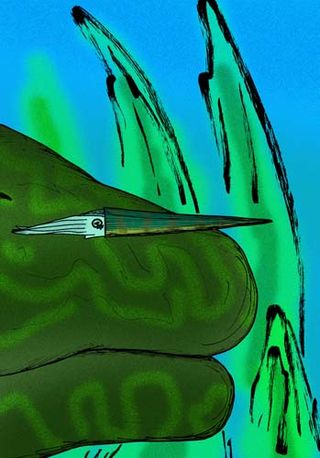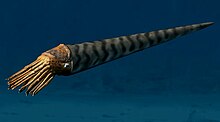
The Nautilida constitute a large and diverse order of generally coiled nautiloid cephalopods that began in the mid Paleozoic and continues to the present with a single family, the Nautilidae which includes two genera, Nautilus and Allonautilus, with six species. All told, between 22 and 34 families and 165 to 184 genera have been recognised, making this the largest order of the subclass Nautiloidea.

Orthoceratidae is an extinct family of actively mobile carnivorous cephalopods, subclass Nautiloidea, that lived in what would be North America, Europe, Asia, Africa, and Australia from the Ordovician through Triassic from 490—203.7 mya, existing for approximately 286.4 million years.
The Ellesmerocerida is an order of primitive cephalopods belonging to the subclass Nautiloidea with a widespread distribution that lived during the Late Cambrian and Ordovician.

The Tarphycerida were the first of the coiled cephalopods, found in marine sediments from the Lower Ordovician to the Middle Devonian. Some, such as Aphetoceras and Estonioceras, are loosely coiled and gyroconic; others, such as Campbelloceras, Tarphyceras, and Trocholites, are tightly coiled, but evolute with all whorls showing. The body chamber of tarphycerids is typically long and tubular, as much as half the length of the containing whorl in most, greater than in the Silurian Ophidioceratidae. The Tarphycerida evolved from the elongated, compressed, exogastric Bassleroceratidae, probably Bassleroceras, around the end of the Gasconadian through forms like Aphetoceras. Close coiling developed rather quickly, and both gyroconic and evolute forms are found in the early middle Canadian.

Lamellorthoceratidae is a family of fossil orthoceratoids in the Orthocerida, defined by Curt Teichert in 1961. The lamellorthoceratids are placed in the superfamily Orthocerataceae in the Treatise on Invertebrate Paleontology.

Pseudorthocerida is an order of generally straight longiconic orthoceratoids with a subcentral to marginal cyrtochoanitic siphuncle composed of variably expanded segments which may contain internal deposits that may develop into a continuous parietal lining.. Cameral deposits are common and concentrated ventrally. Apices typically have a slight to moderate exogastric curvature
Baltoceratidae is an extinct family of orthoconic cephalopods belonging to the subclass Nautiloidea endemic to what would be Asia, Australia, Europe, North America, and South America during the Ordovician living from about 480–460 mya, existing for approximately 20 million years.

Geisonoceratidae is an extinct family of orthoceroid cephalopods endemic to what would be Asia, Europe, and North America from the Middle Ordovician to the Middle Devonian living from about 470—380 mya, existing for approximately 90 million years. With the possible addition of an Early Cretaceous orthocerid from the western Caucasus the range of this group increases dramatically to some 350 million years, thus making it one of the longest lived families of the Nautiloidea.
Pseudorthoceratidae is an extinct family of actively mobile aquatic carnivorous cephalopods belonging to the subclass Orthoceratoidea endemic to what would be North America, Asia, and Europe during the Silurian living from 460.5—251 Ma, existing for approximately 209.5 million years.

Dawsonoceratidae is an extinct family of orthoconic nautiloid cephalopods that lived in what would be North America and Europe from the Late Ordovician through the Middle Devonian from about 480–390 mya, existing for approximately 90 million years.

Cycloceras is an extinct nautiloid cephalopod genus from the Carboniferous of Western Europe, of unknown affinity with the Orthocerida.
Donacoceras is an extinct genus of actively mobile carnivorous cephalopod, essentially a Nautiloid that lived in what would be North America during the Ordovician from 460.5—443.7 mya, existing for approximately 16.8 million years.
Garryoceras is an extinct genus, probably from the actively mobile carnivorous cephalopod order Orthocerida, that lived in what would be North America during the Late Ordovician, from 460.5—443.7 mya, existing for approximately 16.8 million years.

Narthecoceratidae is an extinct family of orthocone cephalopods who lived in marine environments in what is now North America during the Ordovician from 460.5—449 mya, existing for approximately 11.5 million years.
Pseudorthocerataceae is an extinct superfamily of actively mobile carnivorous cephalopod, essentially a Nautiloid, that lived in what would be North America, Europe, Australia, and Asia during the Ordovician from 490—445.6 mya, existing for approximately 44.4 million years.

Orthoceratoidea is a major subclass of nautiloid cephalopods. Members of this subclass usually have orthoconic (straight) to slightly cyrtoconic (curved) shells, and central to subcentral siphuncles which may bear internal deposits. Orthoceratoids are also characterized by dorsomyarian muscle scars, extensive cameral deposits, and calciosiphonate connecting rings with a porous and calcitic inner layer.

Rutoceratidae is a family of prototypical nautilids, derived probably from either Brevicoceratidae or Acleistoceratidae of the order Oncocerida early in the Devonian. Rutoceratidae comprise a family within the oncocerid superfamily Tainocerataceae They are generally characterized by cyrtoconic and gyroconic shells, commonly with spines, nodes, or frills, although some included genera are almost orthoconic, and a commonly empty, tubular ventral siphuncle.
The Orthocerataceae is a superfamily of orthocerid cephalopods that lived from the late Early Ordovician to the Early Cretaceous, but is no longer in general use.

The Lituitidae are a family of evolved tarphycerids characterized by a long orthoconic section that follows a coiled juvenile portion at the apex, along with a generally tubular siphuncle, which like that of the barrandeocerids is composed of thin connecting rings.
Jaochimoceras is a genus of orthoceroid cephalopods from the Silurian of Central Europe (Bohemia) named by Baskov, 1960, and included in the Geisonoceratidae. As with the orthocerids, its shell is longiconic, siphuncle more or less central, and chambers somewhat long.












